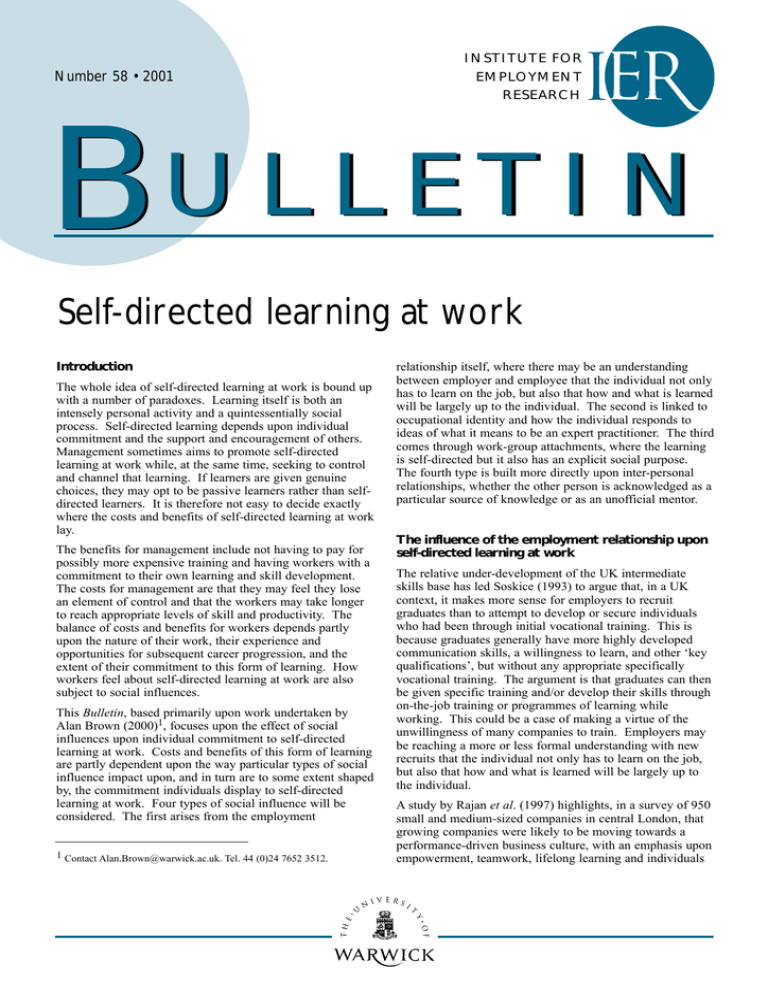B U L L E T I N Self-directed learning at work
advertisement

Number 58 • 2001 INSTITUTE FOR EMPLOYMENT RESEARCH BU L L E T I N Self-directed learning at work Introduction The whole idea of self-directed learning at work is bound up with a number of paradoxes. Learning itself is both an intensely personal activity and a quintessentially social process. Self-directed learning depends upon individual commitment and the support and encouragement of others. Management sometimes aims to promote self-directed learning at work while, at the same time, seeking to control and channel that learning. If learners are given genuine choices, they may opt to be passive learners rather than selfdirected learners. It is therefore not easy to decide exactly where the costs and benefits of self-directed learning at work lay. The benefits for management include not having to pay for possibly more expensive training and having workers with a commitment to their own learning and skill development. The costs for management are that they may feel they lose an element of control and that the workers may take longer to reach appropriate levels of skill and productivity. The balance of costs and benefits for workers depends partly upon the nature of their work, their experience and opportunities for subsequent career progression, and the extent of their commitment to this form of learning. How workers feel about self-directed learning at work are also subject to social influences. This Bulletin, based primarily upon work undertaken by Alan Brown (2000)1, focuses upon the effect of social influences upon individual commitment to self-directed learning at work. Costs and benefits of this form of learning are partly dependent upon the way particular types of social influence impact upon, and in turn are to some extent shaped by, the commitment individuals display to self-directed learning at work. Four types of social influence will be considered. The first arises from the employment 1 Contact Alan.Brown@warwick.ac.uk. Tel. 44 (0)24 7652 3512. relationship itself, where there may be an understanding between employer and employee that the individual not only has to learn on the job, but also that how and what is learned will be largely up to the individual. The second is linked to occupational identity and how the individual responds to ideas of what it means to be an expert practitioner. The third comes through work-group attachments, where the learning is self-directed but it also has an explicit social purpose. The fourth type is built more directly upon inter-personal relationships, whether the other person is acknowledged as a particular source of knowledge or as an unofficial mentor. The influence of the employment relationship upon self-directed learning at work The relative under-development of the UK intermediate skills base has led Soskice (1993) to argue that, in a UK context, it makes more sense for employers to recruit graduates than to attempt to develop or secure individuals who had been through initial vocational training. This is because graduates generally have more highly developed communication skills, a willingness to learn, and other ‘key qualifications’, but without any appropriate specifically vocational training. The argument is that graduates can then be given specific training and/or develop their skills through on-the-job training or programmes of learning while working. This could be a case of making a virtue of the unwillingness of many companies to train. Employers may be reaching a more or less formal understanding with new recruits that the individual not only has to learn on the job, but also that how and what is learned will be largely up to the individual. A study by Rajan et al. (1997) highlights, in a survey of 950 small and medium-sized companies in central London, that growing companies were likely to be moving towards a performance-driven business culture, with an emphasis upon empowerment, teamwork, lifelong learning and individuals 2 managing their own careers. Graduates were ‘reckoned to have intellectual and behavioural traits more in tune with the main elements of the new culture’ (Rajan et al., 1997, p.13). The training methods most frequently used with new graduate recruits were learning by doing; coaching by line managers; interacting with suppliers and customers; and through the exercise of significant work responsibilities. These dominant methods make use of mentoring and experiential learning, but in the main ‘graduates are thrown in at the deep end from the outset; with much of the training coming through learning by doing’ (Rajan et al., 1997, p.24). The central London labour market may be a special case in some respects, but it would appear that at the heart of the employment relationship is a very different conception of the rights and duties of employers and employees, not least in the area of learning and training. Employers are targeting the employment of inexperienced young people (for example, graduates without appropriate specialist knowledge) and relying upon their willingness and commitment to learning (and to working long hours, if necessary) to become effective in their jobs in a relatively short space of time. After a couple of years the employee has built up work-related experience so that he or she is able to apply for jobs with other firms, where previously they would have been considered insufficiently qualified. It is almost as if there is a short-term bargain that the employer will give new entrants the opportunity to establish themselves in the particular occupation and/or work environment, but the extent to which you are successful will depend less upon how well trained you are for exercising your role and more upon how well you can learn through working. In such circumstances the ability to engage in effective self-directed learning can make a difference between success and failure in the job. Now such a work environment could be perceived as permissive, challenging or exploitative, depending partly upon the extent to which self-directed learning is supported at critical points. The issue of learning and development could be attaching itself to the wage-work nexus traditionally seen at the heart of the employment relationship. Companies too are faced with issues of control. If they facilitate self-directed learning, they are faced with a challenge of balancing management and freedom in learning: ‘how can we relax control over the learning process while at the same time channelling the benefits from it?’ (Jones and Hendry, 1994, p.160). Fully self-directed learning at work requires individuals not only to learn from work, but also to use their own initiative to find out what they need to know. The learner/worker, however, might still require support. Companies then have to pay attention to the need to develop learner independence within programmes of work-based learning, including learning while working. One role for trainers is to ensure there are opportunities for reflection within such programmes so that individuals become more effective at acquiring methods of self-learning and techniques for individual development. Hence in any new form of employment compact the rights and duties of both employees and employers will need to be carefully considered. However, what is apparent is that the employment relationship can itself be operating as a major influence upon how self-directed learning operates in practice. The influence of occupational identity upon selfdirected learning at work The following example illustrates how individuals are influenced in their approach to self-directed learning by their developing occupational identity. Diagnostic radiographers, working in hospitals, have to ‘produce a picture fit for the purpose in a reasonable time using a wide range of equipment in a variety of different locations and in different circumstances’ (Eraut et al., 1998, p.17). For example, they may work in theatres or specialist units as well as in their own department, or they may be working alone overnight. Radiographers also have to accommodate to ‘local ways of presenting the pictures (common views and angles and reporting procedures) to meet the preferences of different medical staff. They also need to be able to manage patients with different levels of tolerance, comfort and anxiety under varying medical circumstances. They work as part of a team and have to appreciate the different roles and challenges confronting other members of that team. They may be called upon to teach or supervise others. Overall, they need the technical know-how to make things work and get what they want and the personal skills involved in relating to internal and external customers’ (Eraut et al., 1998, p.18). The key point about this detailed delineation of what radiographers do is to emphasise the general point that formal education and training (and certification) contribute to only a small proportion of learning at work (Eraut et al., 1998). In particular, a developing understanding of situations, colleagues, the work unit and the organisation are examples where learning primarily occurs while working, rather than in a formal setting. Similarly, much learning that occurs at work depends upon utilisation of knowledge resources outside formal education and training settings. Thus radiographers learn from fellow radiographers in their immediate work group, other colleagues, and utilise a ‘rich variety of professional networks ... largely dependent on personal contacts.... [and] “invisible colleges”…. which extended beyond close personal contacts but also depended on occasional meetings for their sustenance’ (Eraut et al., 1998, p.25). The challenges inherent in the work itself, including being ‘on call’ and the need for on-going mutual consultation with colleagues, stimulate learning while working for radiographers (Brown et al., 2000). Support for both formal and informal learning is therefore often quite strong. The richness and variety of learning opportunities does mean that there is a strong expectation, within the community of radiography practice, that practitioners will continue to learn so as to maintain their occupational identity as a competent practitioner, and further that each individual will take control of how they learn. In respect of how each individual integrates what he or she has learned then the learning is self-directed. 3 The essential point here is that learning of new skills and techniques comprises only one aspect of continuing professional development. The work of a radiographer as a whole encompasses much more in terms of experience, learning and development than mastery of particular techniques. This means that to be acknowledged by colleagues and others as an experienced professional, capable of high level performance in a wide variety of settings and contexts, carries great weight even when not accompanied by additional formal qualifications. It is the judgement of peers, and internalised, but changing, notions of professionalism, that can be seen as the driving forces behind the patterns of self-directed learning of radiographers. Attempts have been made to incorporate at least some of this informal learning within formal practicebased additional qualifications. These seek to engage more fully with a variety of aspects of performance in current and possibly future roles, with an emphasis upon developing a deeper understanding of practice, coupled with a broader programme aimed at facilitating further learning and development. Such formal programmes are therefore explicitly recognising and supporting self-directed learning, and reinforcing the idea that the ability to engage in selfdirected learning is a key component of occupational identity. The influence of an attachment to a work group upon self-directed learning at work One of the traditional ways of viewing adult learning was that one of its major purposes was to help individuals gain some control over a complex world. Such learning could then play a transformative role (Brookfield, 1986) in giving individuals greater potential to shape aspects of their own lives. From this perspective the disregard of employees as organisers of their own learning is problematic (Poell, 1998), as when employees are viewed as just reactive to the strategies of trainers and managers. A challenge to this type of thinking, given the structure of social relations at work, is much more likely to be a collective rather than an individual effort. The social nature of work-related learning is perhaps most clearly evident in those cases where an individual forms a close attachment to her or his immediate work-group. This not only draws attention to the social context in which knowledge is acquired, developed and applied, but also how it influences the processes by which the individual learns. Indeed the basic structures for the interpretation of experience can themselves be shared, developed and changed through interaction with other members of the work-group (Brown, 1997). Individuals learn what type of learning will be useful to share with colleagues, and they also learn about where and from whom further knowledge could be gained. Orr (1996) highlighted the social nature of work-related knowledge, by analysing the behaviour of photocopier maintenance technicians who develop their knowledge over time through problem-solving and continuous interaction. The defects of the machines they have to cope with are often very different to the ones reported in the standard operating manuals. Therefore problem-solving and problem-setting happen collectively on the basis of previous experiences of each member of the group and on the basis of various types of communication, even the informal chatting around the coffee-machine. This way, knowledge is continuously created and maintained within a specific community of practice, having its own language and myths (developed partly through the handing down of war stories, reporting the main events of machine repairing and client dealing). In this way individuals can learn from the experience of others, and also shape their own learning. Some organisations are also devolving increasing responsibility for learning and development to the workgroup, so that for those working in teams at the workplace, these teams become a focus of support for learning. The social context created by a co-operative approach can also enhance the motivation and commitment of the learners. In this way collaborative learning can not only help individuals to transfer their skills, knowledge and understanding between contexts, but also expose individuals to different strategies for making these connections. Overall then, involvement with and commitment to a work-group may influence individual commitment to all forms of learning at work, including self-directed learning. The influence of personal relationships upon selfdirected learning at work Personal relationships can also play a significant role in encouraging an individual to engage in self-directed learning at work. Although the encouragement of others can also give a focus to self-directed learning at work that goes beyond the immediate context. An example of this was a modern languages teacher at a secondary school, who received considerable encouragement from a local Information Technology (IT) Adviser to develop innovative ways to use IT to enhance foreign language teaching. The programme of development undertaken by the teacher depended upon his commitment to self-directed learning, but was underpinned by the encouragement of the adviser. Significantly, this encouragement was social rather than practical: valuing the work and using the teacher to demonstrate good practice at staff development sessions elsewhere in the county. The more social approbation the teacher received the more driven he was in his programme of self-directed learning and his commitment to be at the leading edge of innovation in foreign language teaching. The teacher eventually was spending up to thirty hours a week on development in addition to a full teaching load. By this time, however, the teacher’s reference group was not his immediate community of practising teachers, but rather the wider education community. Upon the back of the reputation as an innovative teacher he was able to secure a national advisory post. Now this case illustrates the dual nature of even self-directed learning as both individual and social. For long periods the 4 teacher was learning on his own. However, the reflexive dimension to what he was doing, the value of what he was doing and how he was developing as a learner was reinforced through the relationship with the adviser and in meetings with fellow teachers, who recognised the worth of his development work. Now recognition of personal worth by an influential sponsor or mentor and recognition by your community of peers can be powerful drivers to individual programmes of self-directed learning. That this anecdote is not an isolated case can be seen from the work of Eraut et al. (1998), who found many examples of organised but relatively informal learning support through reference to unofficial sponsors, mentors or ‘designated experts’, where the support was a function of a personal network of relationships. Concluding comments The different types of social influence already considered impact upon individual commitment to self-directed learning at work. In practice though a number of these communal and inter-personal influences may be operating upon any one individual, as individuals may be part of a complex network of relationships at or through work. Now particularly where individuals are in roles involving significant learning and development, then some of these networks will be explicitly concerned with knowledge creation, development and transformation, and these will be underpinned by complex sets of social relationships. In such circumstances access to and participation in these networks will greatly influence what and how an individual learns. It might be argued, however, that this has little to do with self-directed learning, it can be explained in terms of a newcomer learning to become a full member of the network through a process of ‘legitimate peripheral participation’ (Lave and Wenger, 1991). However, this ignores three factors. First, the individual acts to change and shape the evolving network, which is a dynamic rather than a static entity (Brown, 1997). Second, the individual has to make choices about the nature, location, type of their contribution and so on. Third, the very complexity of these networks and their underpinning social relationships means that in a very real sense the direction of the individual’s learning has to be under the control of the individual. Hence we return to a paradox: the sheer number, complexity and variety of social influences upon how an individual learns at work, when their role requires significant learning and development, means that the learning has in one sense at least to be essentially self-directed. An examination of the value of self-directed learning at work might be thought to be amenable to a simple review of the costs and benefits to individuals and companies. However, individualistic accounts of learning which do not acknowledge the social dimension to learning are insufficient, and so are accounts of learning organisations that operate with simplistic assumptions about individual knowledge development and transfer. Knowledge development and learning in organisations should be viewed as social processes (Lave and Wenger, 1991). Individual learning at work is mediated by the perspectives of others about what should be learned and how it should be learned, even where the learning is largely self-directed. The perspectives of other individuals towards learning are similarly not free-standing, but rather are linked in some way to particular communities of practice, which develop a collective ‘knowledgeability’. Individual learning at work therefore needs to be understood in terms of specific contexts, with particular communities of practice, and specific sets of relationships within those communities. Viewed in this way, from whom individuals learn and from whom they take their ideas about learning at work is itself an important issue. The nature, direction, extent and commitment of an individual to self-directed learning at work can therefore be strongly influenced by the set of social relationships an individual has with others at and through work. References Brookfield, S. (1986). Understanding and facilitating adult learning: a comprehensive analysis of principles and effective practices. Milton Keynes: Open University Press. Brown, A. (1997). ‘A dynamic model of occupational identity formation’. Promoting vocational education and training: European perspectives. Ed. A. Brown. Tampere: University of Tampere Press. Brown, A. (2000). ‘Social influences on individual commitment to self-directed learning at work’. Conceptions of self-directed learning. Ed. G. Straka. Muenster: Waxmann. Brown, A., A. Green, J. Pitcher and C. Simm (2000). Employers skill survey: case study – health and social care. National Skills Task Force Research Report 35. Nottingham: DfEE. Eraut, M., J. Alderton, G. Cole and P. Senker (1998). Development of knowledge and skills in employment. Institute of Education Research Report 5. Falmer: University of Sussex. Jones, A. and C. Hendry (1994). ‘The learning organisation: Adult learning and organisational transformation’. British Journal of Management, no. 5, 153-162. Lave, J. and E. Wenger (1991). Situated learning: legitimate peripheral participation. Cambridge: Cambridge University Press. Orr, J. (1996). Talking about machines: an ethnography of a modern job. Ithaca, NY: IRL press. Poell, R. (1998). Organising work-related learning projects: a network approach. PhD thesis, Catholic University of Nijmegen. Nijmegen: Poell. Rajan, A., K. Chapple and I. Battersby (1997). Graduates in growing companies: the rhetoric of core skills and reality of globalisation. London: FOCUS Central London. Soskice, D. (1993). ‘Social skills from mass higher education: rethinking the company-based initial training paradigm’. Oxford Review of Economic Policy, 9, no. 3, 101-113. © Institute for Employment Research 2001 ISSN: 0954-7932 Published by IER, University of Warwick




